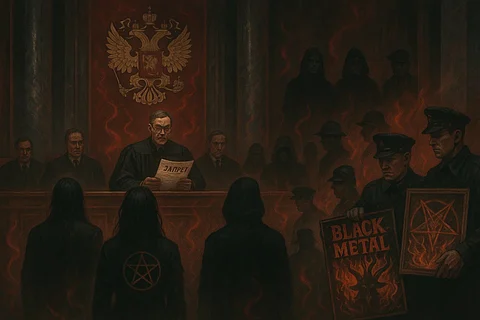
- Home
- न्यूजग्राम
- NewsGram USA
- India
- World
- Politics
- Entertainment
- Culture
- Lifestyle
- Economy
- Sports
- Sp. Coverage
- Misc.
- NewsGram Exclusive
- Jobs / Internships

Key Points:
Russia’s Supreme Court declared the “International Satanism Movement” an extremist group, despite no official evidence of its existence.
Authorities claimed the movement promotes hatred toward religion, ritual crimes, and possible ties to radical nationalism and neo-Nazism.
The ban reflects a trend of labelling as extremist those challenging government authority and social norms.
Satanism consists of a diverse set of beliefs and norms; it can range from religious to philosophical or even ideological credence that revolves around the devil. However, not every form of Satanism is centred on worshipping him as a spiritual deity. In some variations, Satanism is interpreted as an emblem of rebellion or as a philosophy that emphasizes individualism.
But can the phenomenon of Satanism still be associated with the literal worship of the devil, especially in modern times? Modern Satanism began in 1966, when the Church of Satan was founded by Anton LaVey. This movement focused on personal empowerment and individualism rather than the worship of Satan as a deity.
Although modern interpretations of Satanism have begun to intertwine with politics, aiming to bring about social change and political transformation, the Devil—once a fallen angel who rebelled against God—serves as a symbol for many modern-day Satanists to challenge dominant power structures and prevailing ideologies in society.
With multiple narratives surrounding Satanism, its presence is perceived as an active threat in a powerful statehood like Russia. Satanism-themed art, or its inclusion in music, literature, or visual media, might now be considered illegal in the country. These occult themes often inspire various art forms and music genres such as heavy metal, death metal, and goth metal, which frequently explore content influenced by death, demonic imagery, and Satanism.
Is the apex court’s decision to ban the Satanism movement a move to persecute individuals who rebel against the government, traditional social structures, and religious norms? Could simply wearing an inverted pentagram symbol now get you into trouble?
The Supreme Court of Russia has put another ban on a non-existent movement. The court has officially declared the International Satanism Movement an extremist group. The case was brought forward by the Russian Prosecutor General’s Office and the Ministry of Justice. They demanded the banishment of the movement and declared all activities related to it as illegal.
See Also:
Russia’s top court’s verdict to ban the Satanism-inclined movement was filed by the Prosecutor General of the Russian Federation, Igor Krasnov. The decision was based on the information that the movement was rooted in “extremist ideologies,” which threatened traditional religious sentiments of Russia. The movement's name suggests that it upholds an official title and has a fully recognised organisation — but the International Satanism Movement does not exist and its existence is not recognised in any official documentation.
The Prosecutor General’s Office released a statement explaining the motive behind the alleged Satanism movement in Russia. They stated: “As established, the movement is based on extremist ideology, hatred, and hostility toward traditional religious confessions.”
The prosecutor’s office accused the movement of being involved in inciting violence against traditional religious institutions and of having alleged ties to radical nationalism and neo-Nazism.
Back in April 2025, during a session in the lower house of the Russian Parliament — the Duma — a discussion was conducted which aimed to expose the connection between rising Satanism in Russia and the “hybrid warfare” used by Western forces. MP Andrei Kartapolov, head of the Duma’s Defence Committee, argued that Satanism is a “direct threat” to Russia. He questioned whether the USA was backing the cult as a means to weaken the nation:
“Where are their books and posters printed? Who pays for their concerts, shows, performances, the renting of halls, bars, clubs?” asked MP Kartapolov.
The prosecutor’s office also alleged that individuals from the movement were involved in heinous acts, such as crimes against minors and allegedly committing suspicious ritual murders. Russia’s Deputy Justice Minister, Oleg Sviridenko, shared that the ban on the cult movement was the result of efforts by both law enforcement and the judiciary. Conservative lawmakers have long been in discussions to make Satanism-related activities illegal.
However, this is not the Russian Supreme Court’s first instance of banning a non-existent movement. The court had previously banned another movement — the LGBTQ+ movement — and called it a fictitious group. The verdict to ban the movement was further used as a basis to take action against any potential work that represented the LGBTQ+ community or its individuals. Russian news outlet Meduza wrote that the SC “used that designation to persecute LGBTQ+ individuals and censor artistic works.”
[Rh/VS]
Also Read:
